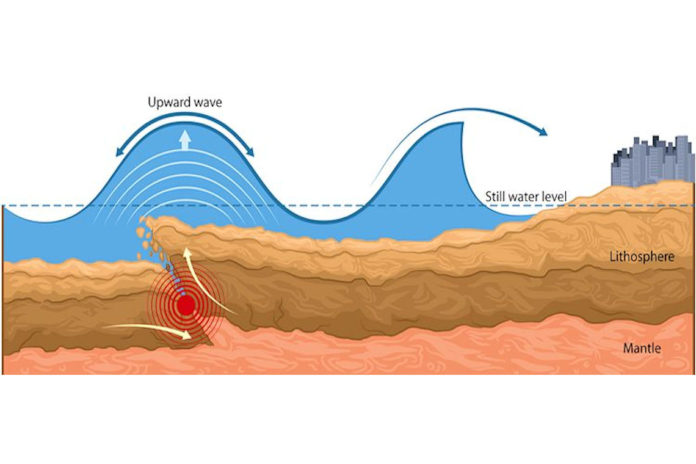A tsunami is a series of sea waves that may be triggered by earthquakes, landslides, and volcanoes. These natural hazards displace a large amount of water. This displacement creates a large wave that can affect coastal areas. A typical seismic sea wave is about 10 meters high.
Events That Can Trigger a Tsunami
Tsunamis are caused by the following events:
Earthquake
A large earthquake can displace a large amount of water. Seismic sea waves from an earthquake can travel thousands of miles.
Damage from one tsunami can affect a large area. In 2004, an earthquake off the coast of Indonesia generated a tsunami that affected coastlines from Asia to Africa. That tsunami took over 290,000 lives. The 2011 Tohuku earthquake generated a sea wave that caused billions of dollars of damage in Japan.
Landslides and Volcanoes
Seismic sea waves are also triggered by landslides. A 1958 landslide in Alaska created a wave that was over 500 meters high. Volcanic eruptions may also trigger tsunamis. The 1883 eruption of Krakatoa created several waves over 30 meters high.
Meteors
In the earth’s past, large meteors have struck the earth. These can trigger huge sea waves. The Chicxulub meteor generated an initial wave that was 1,500 meters high. This event occured 66 million years ago.
What Makes a Tsunami Dangerous?
A seismic sea wave is barely noticeable in the deep ocean. However, it can move at speeds up to 800 kilometers an hour. As the wave approaches land it begins to slow down and increase in height. Sometimes in coastal areas, the ocean will recede and expose the sea bed. When a drawback of water like this occurs, the tsunami will arrive within a few minutes.
As the water moves inland it begins to pick up debris. This can include cars, boats, trees, homes which can add to the destructive nature of the wave.
Reflections
Vocabulary
- earthquake
- landslide
- tsunami
Notes
- A tsunami or seismic sea wave is created earthquakes, landslides, or volcanoes.
- The wave is barely noticeable in deep water, but will grow in size once the water reaches the coast.
- A typical seismic sea wave is 10 meters high.
Bibliography
- A Hydrosphere Study Guide
- About the Hydrosphere.
- NOAA Tsunami Website, NOAA.

